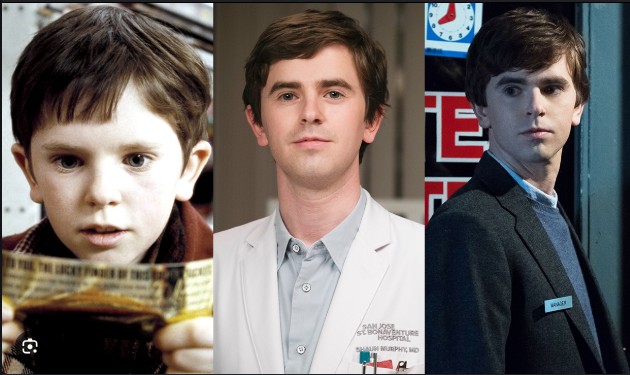
“Finding Neverland” explores the relationship between playwright J.M. Barrie (Johnny Depp) and the Llewelyn Davies family, particularly the four young brothers who inspired Barrie’s masterpiece “Peter Pan.” Highmore portrayed Peter Llewelyn Davies, the second-oldest brother struggling to process his father’s recent death while facing his mother’s terminal illness. The role demanded an extraordinary emotional range: childlike play and imagination juxtaposed against premature confrontation with mortality and loss.
The performance required Highmore to maintain a delicate balance between vulnerability and resilience. Peter’s character serves as both the emotional heart of the film and its greatest skeptic—the child most resistant to Barrie’s imaginative world precisely because he understands most clearly what imagination cannot change or fix. Highmore navigated this contradiction with remarkable subtlety, allowing audiences to witness both Peter’s defensive anger and his desperate longing for escape through fantasy.
Johnny Depp, no stranger to working with talented child actors after “Charlie and the Chocolate Factory” (which would later reunite him with Highmore), expressed admiration for his young co-star’s instinctive approach to emotional scenes. “Some actors build characters from the outside in—they find mannerisms, a voice, external characteristics. Freddie, even at that young age, worked from the inside out. He found the emotional truth first, and everything else flowed from that.”

This emotional authenticity is particularly evident in the film’s most challenging sequences, as Peter witnesses his mother’s decline. In these scenes, Highmore conveys the particular helplessness of a child confronted with adult suffering—the confusion, the anger, and most poignantly, the premature assumption of responsibility that often accompanies such experiences. His performance suggests not just sadness but a complex web of emotions: guilt at moments of happiness, resentment of adults’ failed promises, and terror at the instability of a world where parents can disappear.
Kate Winslet, who played Sylvia Llewelyn Davies, described working with Highmore as “humbling” and noted that his performance often elevated everyone around him. “There were moments when I would find myself responding genuinely to the emotion Freddie brought to a scene, forgetting that this was a child actor. He has this remarkable ability to be fully present in imaginary circumstances.”
Perhaps most impressively, Highmore achieved this emotional resonance without sacrificing the essential childlikeness of Peter. His performance never feels precocious or artificially mature; instead, it captures the specific way children experience and express profound emotions—often sideways, through play, resistance, or sudden outbursts. This authenticity speaks to Highmore’s instinctive understanding of the character’s psychological reality.
The critical response to Highmore’s performance was overwhelmingly positive. The New York Times called him “extraordinarily fine,” while Roger Ebert noted that he “has the difficult task of playing a boy whose imagination has been damaged by grief, and does it with such delicacy that we don’t notice how difficult the performance is.” The role earned Highmore several awards, including the Critics’ Choice Movie Award for Best Young Performer and the Empire Award for Best Newcomer.
The film’s exploration of imagination as both escape and healing—of stories as tools for processing unbearable realities—resonates particularly strongly when considered alongside Highmore’s career development. As an actor, he has consistently chosen roles that explore the porousness between fantasy and reality, the ways individuals construct protective psychological narratives, and the therapeutic potential of imagination. From Peter Llewelyn Davies to Norman Bates, Highmore has portrayed characters whose inner worlds serve as both refuge and trap.
Perhaps most significantly, “Finding Neverland” introduced audiences to Highmore’s most distinctive quality as a performer: his extraordinary emotional transparency. His acting has always been characterized by a willingness to appear vulnerable, to allow viewers access to his characters’ internal landscapes without artifice or defense. This quality, evident even in his earliest major role, has enabled him to create characters of remarkable psychological complexity throughout his career.
As Highmore has matured as an actor, the seeds planted in his “Finding Neverland” performance have flowered into a body of work characterized by emotional intelligence, psychological depth, and technical mastery. Looking back, one can see in Peter Llewelyn Davies the blueprint for what would become Highmore’s signature approach to character: finding the emotional truth first and allowing everything else to follow from that foundation.
In the years since “Finding Neverland,” Highmore has navigated the treacherous transition from child to adult actor with exceptional grace, avoiding the pitfalls that have derailed so many young performers’ careers. The emotional authenticity that distinguished his portrayal of Peter has remained his greatest strength, allowing him to create characters who feel not performed but inhabited—individuals whose inner lives we are privileged to witness. In this sense, “Finding Neverland” was not just Highmore’s breakthrough role but a promise of the extraordinary actor he would become.
